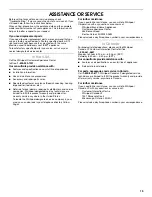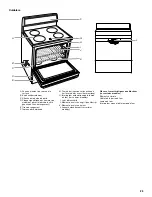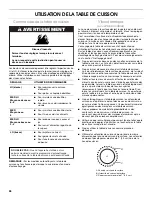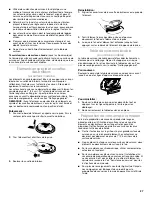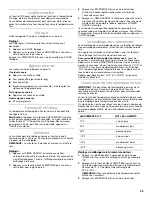
16
Metal marks from aluminum and copper
■
Cooktop Polishing Creme:
Clean as soon as cooktop has cooled down. Rub creme into
surface with a damp paper towel or soft cloth. Continue
rubbing until white film disappears. The marks will not totally
disappear, but after many cleanings they will become less
noticeable.
Tiny scratches and abrasions
■
Cooktop Polishing Creme:
Rub creme into surface with a damp paper towel or soft cloth.
Continue rubbing until white film disappears. Scratches and
abrasions do not affect cooking performance, and after many
cleanings they will become less noticeable.
COOKTOP CONTROLS
Do not use steel wool, abrasive cleansers or oven cleaner.
Do not soak knobs.
When replacing knobs, make sure knobs are in the Off position.
On some models, do not remove seals under knobs.
■
Soap and water or dishwasher:
Pull knobs straight away from control panel to remove.
CONTROL PANEL
Do not use abrasive cleaners, steel-wool pads, gritty washcloths
or some paper towels. Damage may occur.
■
Glass cleaner and soft cloth or sponge:
Apply glass cleaner to soft cloth or sponge, not directly on
panel.
COIL ELEMENTS (on some models)
Do not clean or immerse in water. Soil will burn off when hot.
For more information, see “Coil Elements and Burner Bowls.”
■
Damp cloth:
Make sure control knobs are off and elements are cool.
BURNER BOWLS (on some models)
■
Solution of
¹₂
cup (125 mL) ammonia to 1 gal. (3.75 L) water:
Soak for 20 minutes, then scrub with stainless steel-wool pad.
■
Oven cleaner:
Follow product label instructions.
■
Mildly abrasive cleanser:
Scrub with wet scouring pad.
Porcelain enamel only, not chrome
■
Dishwasher
SURFACE UNDER COOKTOP (on some models)
Do not remove the cooktop to avoid product damage.
For more information, see “Lift-up Cooktop” section.
■
Steel-wool pad
OVEN DOOR EXTERIOR
■
Glass cleaner and paper towels or nonabrasive plastic
scrubbing pad:
Apply glass cleaner to soft cloth or sponge, not directly on
panel.
OVEN CAVITY
Do not use oven cleaners.
Food spills should be cleaned when oven cools. At high
temperatures, foods react with porcelain and staining, etching,
pitting or faint white spots can result.
■
Self-Cleaning cycle:
See “Self-Cleaning Cycle” first.
OVEN RACKS AND ROASTING RACKS
■
Self-Cleaning cycle:
See “Self-Cleaning Cycle” first. Remove racks or they will
discolor and become harder to slide. If this happens, a light
coating of vegetable oil applied to the rack guides will help
them slide.
■
Steel-wool pad
BROILER PAN AND GRID (on some models)
Do not clean in the Self-Cleaning cycle.
■
Mildly abrasive cleanser:
Scrub with wet scouring pad.
■
Solution of
¹₂
cup (125 mL) ammonia to 1 gal. (3.75 L) water:
Soak for 20 minutes, then scrub with scouring or steel-wool
pad.
■
Oven cleaner:
Follow product label instructions.
Porcelain enamel only, not chrome
■
Dishwasher
STORAGE DRAWER (on some models)
Make sure drawer is cool and empty before cleaning.
For more information, see “Storage Drawer” section.
■
Mild detergent
Drawer Liner (on some models)
Remove all stored items from drawer and lift out drawer liner.
■
Clean with mild detergent.
WARMING DRAWER and TRAY (on some models)
Make sure drawer is cool and remove tray.
■
Mild detergent (for both)


















